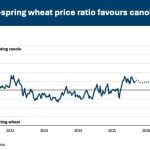If farmers follow through on their intentions, they will plant the biggest crop of flax in 18 years, according to a Statistics Canada survey released last week.
From phone calls with prairie farmers in late March, the agency forecasts they’ll seed 2.28 million acres of the crop.
“We knew that flax was going to be substantially higher, but I certainly didn’t think it was going to be as high as it is,” said Charles Hume, a broker with Keystone Marketing Services in Sedley, Sask.
“This is too much flax, I think, for our market.”
Read Also

Farm Credit Canada partners with major Toronto innovation hub
A FCC parntership with MaRS Discovery District aims to solve technology problems in food supply chains.
The 10-year average for flax in Western Canada is 1.44 million acres. The last time farmers cracked the two-million-acre mark was in 1995 with 2.125 million acres.
With a cold spring and touchy futures prices, many think farmers might change their minds.
“Acreage that’s not cast in stone from an agronomic point of view, I think can change pretty dramatically, depending on what the weather’s like,” said Dulcie Price, a grain marketing broker and president of Optimum Agra Services Ltd. in Winnipeg.
Situation may change
She said flax prices have been dropping during the past couple of weeks, which might discourage some farmers.
Plans for canola also surprised the trade, which anticipated more yellow fields than the 11.585 million acres in the report.
Price expected farmers would plant 400,000 to 500,000 more acres.
Intended canola acres are well above the 10-year average of 8.995 million, but fall short of 1994’s record crop of 14.165 million acres.
Hume said canola futures prices have moved up since the report, and the spread between canola and flax prices has widened.
“We’re seeing basis levels that are very attractive on canola so the handling margins are quite low and that is an encouragement to produce the crop,” Hume said, adding he thinks crushers are worried about another year of canola shortages.
“They (crushers) are going to push that price up until they know they can secure the acres, and I personally think they’re going to get the acres.”
Price said farmers should use November futures prices around $385 to $390 per tonne as a pricing opportunity.
“That’s a nice place to hedge a little bit of canola for new crop,” she said.
More special crops
Aside from the oilseeds, the report contained few surprises. Farmers plan to grow less cereals and more special crops.
Sharlene Mann, a broker with Palliser Commodities in Calgary, said the report leaves barley prices “stuck in a rut.”
“Some are saying we could be falling here $10 by the end of the summer,” Mann said, adding farmers should wait to price new crop or lock in a basis.
The brokers said few farmers have started seeding.
“They’ve barely got spring fever at this point. It’s not warm enough,” said Price.
But weather will drive markets from now into the summer, said the brokers.
“The biggest thing will be weather now. Do they have enough rain once their seeds are in? Was there enough sun?” said Mann.
Price said growers should take advantage of markets when weather concerns push prices higher.
“Growers just have to try not to get too emotional about the weather, recognize that Mother Nature always gives them a chance to get a crop in, and most of the time, off,” Price said.














